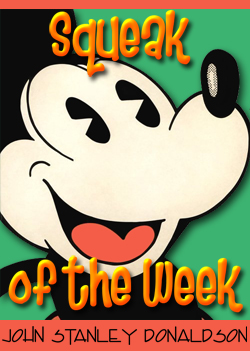FROM: Squeak of the Week Published Fridays
Was Walt About to Be Bamboozled by "Buzz"?
Trusting a man who likes to be called "Buzz" is probably never a smart idea, unless he happens to be an astronaut, but the "Buzz" who nearly bamboozled Walt Disney on a land deal (land intended as the site for Disneyland) was no astronaut, and no angel.
Walt Disney was in Blandland.
A two-acre amusement park, to the corner of Beverly and La Cienega, was a lucky, Los Angeles location - but it was also a petroleum field. Children, such as his daughters, Diane and Sharon, took to ponies, alongside a crude-oil storage tank and open waste pit.
An operating pump was disguised as a cricket.
There had to be something better.
At this time, the architectural firm of Pereira and Luckman had Marineland of the Pacific, a sixty-five acre oceanarium, set in Palos Verdes, being set into blueprint.
Disney asked Luckman to lunch.
Down to the detail, Walt described a park he had in mind.
Charles never got to the pork chop on his plate.
Luckman was asked to design a plan for a wedge of wasteland, to the side of the studio, known as "the gully." This, he did - even though the parcel was too small to present such cream of a dream.
So, Charles unrolled a ten-acre idea, with thought to build somewhere else. As weeks went by, that ten went to twenty. Then twenty went to thirty.
Walt flipped when it got to fifty.
Pereira and Luckman suggested the hiring of the Stanford Research Institute for a confidential location and economic survey.
Harrison "Buzz" Price, of said firm, so handed said report.
Buy an aching amount of acreage, he directed.
At least one hundred and sixty.
Outside of Anaheim.
Walt almost fainted.
"The Stanford Research people," as related by Harper Goff, "said that 'when Walt Disney puts in an amusement park, he's got to have a lot of space.' But Walt was horrified."
"They think I'm making a lot of money," shook Walt, "and they're trying to get me to spend a lot."
But, he really would have been shaken, if he had known of an attempt to be taken.
The Stanford Research Institute was an egghead firm that could be contacted to arrive at an answer on anything - from the origin of air pollution to whether a robotic machine could be foreseen.
A unit manager, Harrison Price, was a man so numbing with numbers there would be an indication to album cover each time a record from his collection was played.
click image to expand:
Photo of Walt Disney, C.V. Wood, Jr., and Harrison "Buzz" Price
Of early entry, in the nerd herd.
As he would tell it, in determining the location of Disneyland, everything from projected shifting of population to pattern of fog and smog was mapped on plastic overlays.
Just to arrive at just the right site.
But, the study quickly shifted to shifty.
Moving from graph to graft.
Seems a fellow by the name of Leo Harvey, shrewd manufacturer of aluminum extrusion, had obtained, a year earlier, six hundred and fifty-three acres of ranch land for just over one million dollars.
Where was it?
Outside of Anaheim.
A quarter section of such was promoted in the presented Disneyland report - and, if purchased, at price Price had within budget, Harvey would not only have effectively received that remaining four hundred and ninety-three acres for free, but its value, on park periphery, would have increased immeasurably.
This was unethical acreage.
Leo Harvey was also a client of Harrison "Buzz" Price.
"You and I are both con men, 'Buzz,'" as Stanford head, C.V. Wood, Jr., would say, "but we deliver the goods."
Well, sort of.
Fact is, the site that did become Disneyland, for which Price would accept a life of accolade, was not of the steered study.
It was inserted from the working of one Fred Wallich.
C.V. Wood would finally be caught as corrupt when, having been made general manager of Disneyland, he was found to have set up a series of personal, shell corporations to be sole supplier of park souvenirs.
He 'resigned' in February of 1956 to pursue other interests.
The same month, Harrison Price 'resigned' from Stanford Research.
For a time, "Buzz" would make a living by selling aluminum siding.
For Leo Harvey.
John Stanley Donaldson, once the protege of Disney Legend Herb Ryman, is the author of Mr. Ryman's biography, Warp and Weft: Life Canvas of Herbert Ryman, which you can purchase directly from the author's site.
More: SQUEAK OF THE WEEK
Stuff Not to Skip
- John Donaldson on the Web
http://www.incanio.com - John Donaldson on Twitter
http://twitter.com/incanio







Comments (0)